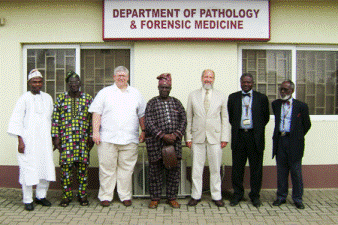Natural Resources, School of

Karl Reinhard Publications
Document Type
Article
Date of this Version
2018
Citation
Published in Am J Forensic Med Pathol, Volume 39, Number 2, June 2018, pp 179-183.
DOI: 10.1097/PAF.0000000000000389
Abstract
In Spring of 2012, the partially undressed and skeletonized remains of a homeless adult Hispanic male was found in a fairly open wooded area in Nebraska. The remains showed evidence of extensive pathologies, which included healed traumas and surgeries. Examination of the decedent's medical records revealed that he had a history of kidney and liver problems, alcohol abuse, several traumas including a major head injury that necessitated a craniotomy, and radiological features of neurocysticercosis. The autologous bone flap, which was replaced after the craniotomy, had resorbed significantly away from the edges of the injury. Death was variously attributed to craniocerebral injury with hypothermia sequel to blunt force trauma most probably due to a fall. The manner of death was ruled as an accident. This study makes use of the forensic evidence and medical records to examine the possibility that the unique combination of failed cranioplasty, hypothermia, and neurocysticercosis may have contributed to the victim's death. Other potential causes of death are considered.
Included in
Archaeological Anthropology Commons, Ecology and Evolutionary Biology Commons, Environmental Public Health Commons, Other Public Health Commons, Parasitology Commons


Comments
Copyright © 2018 Wolters Kluwer Health, Inc. Used by permission.